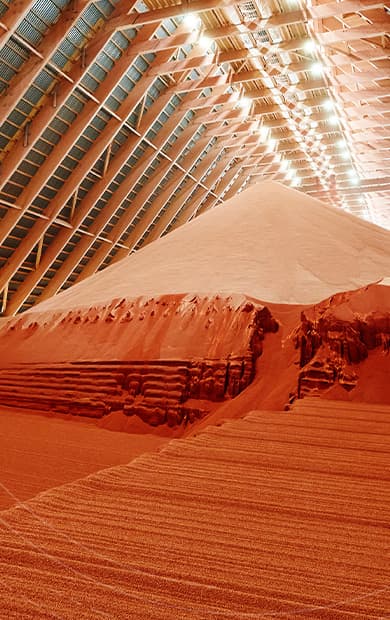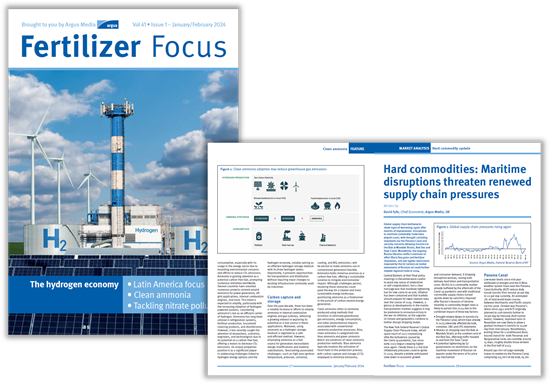

Phosphates
Overview
The global phosphates market has witnessed increasing volatility, in response to military conflicts, political tensions and changing market dynamics. Price fluctuations have continued to buffet the market, with increasing demand from south and Southeast Asia the main regions driving consumption growth. Rising raw material prices and improved affordability have lifted prices once again.
Phosphates' usage is also not solely limited to fertilizers. Battery-material suppliers are increasingly seeking to source phosphate rock and specialty phosphates-based products to meet the rapidly rising demand for lithium-iron-phosphate batteries for electric vehicle production.
Our extensive phosphates coverage includes DAP, MAP, TSP and SSP, as well as raw materials phosphate rock and phosphoric acid, with assessments also spanning feed products MCP and DCP. Argus has many decades of experience covering the phosphates market and incorporate our multi-commodity market expertise in key areas including sulphur and ammonia to provide the full market narrative.
Argus support market participants with:
- Daily and weekly phosphates price assessments, proprietary data and market commentary
- Short and medium to long-term forecasting, modelling and analysis of processed phosphate and phosphate rock prices, supply, demand, trade and projects
- Bespoke consulting project support
Latest phosphate news
Browse the latest market moving news on the global phosphate industry.
India's GSFC receives offers in tender to buy DAP
India's GSFC receives offers in tender to buy DAP
London, 9 May (Argus) — Indian importer GSFC likely received offers from two trading firms ranging in the high-$510s/t cfr to around $520/t cfr, under its 8 May tender to buy 100,000t of DAP. The tender sought offers for 50,000t of natural-coloured DAP and 50,000t of "coffee-brown" DAP for delivery to Kandla or Munda on India's west coast at the end of June or in early July. Fellow importer NFL has scrapped its 6 May tender to buy 50,000t of DAP for delivery by the end of May. It had received one offer from a trading firm. Another importer Smartchem on 8 May issued a counterbid of $479/t cfr against the six offers received in its 6 May tender. The initial offers had ranged from the low-$510s/t cfr to the low-$520s/t cfr. Smartchem gave the companies which had offered until close of business on 9 May to accept. The tender had sought 60,000t of DAP in two 30,000t cargoes for delivery by the second half of June. Importer Hindalco earlier this week awarded its 1 May tender to buy 40,000-45,000t of DAP to a regional trading firm at around $508/t cfr, initially reported as around $509/t cfr. By Tom Hampson Send comments and request more information at feedback@argusmedia.com Copyright © 2024. Argus Media group . All rights reserved.
India’s Coromandel to build Kakinada fertilizer complex
India’s Coromandel to build Kakinada fertilizer complex
Singapore, 2 May (Argus) — Indian fertilizer producer Coromandel International will build a 650 t/d phosphoric acid-sulphuric acid complex facility in Kakinada, Andhra Pradesh with an investment of approximately 10bn rupees ($120mn). The project is expected to commission in two years' time, CIL's executive chairman Arun Alagappan said on 26 April. Phosphoric acid and sulphuric acid are used in the production of phosphate fertilizers like DAP and NPKs. CIL's new phosphoric acid facility aims to provide for its fertilizer manufacturing and to replace more than 50pc of the plant's import requirements. It also plans to build a 1,800 t/d sulphuric acid plant to supplement phosphoric acid production. By Deon Ngee Send comments and request more information at feedback@argusmedia.com Copyright © 2024. Argus Media group . All rights reserved.
Phosphates: Indian DAP stocks build in March
Phosphates: Indian DAP stocks build in March
London, 19 April (Argus) — DAP stocks rose by the equivalent of 2-3 import cargoes in March, or nearly 86,000t, as imports and local production outstripped offtake. Indian DAP production reached 218,900t in March, according to FAI data, down nearly 41pc on the same month in 2023. DAP imports reached 201,000t in March, down nearly 54pc on March 2023. Sales of DAP reached 334,200t, down nearly 12pc year on year. Stock draw/build, defined as production plus imports minus offtake, was plus 85,700t. This implies that stocks are still close to 2mn t of DAP, as estimated by the Indian government. Full fertilizer year DAP production (April 2023-March 2024) reached 4.29mn t, down around 1pc year on year. Imports were down 15.4pc at 5.57mn t, mainly due to the loss of supply from China owing to customs inspections, with sales at 10.8mn t, up nearly 4pc year on year. By Mike Nash Send comments and request more information at feedback@argusmedia.com Copyright © 2024. Argus Media group . All rights reserved.
Australia provides $256mn to high-purity alumina plant
Australia provides $256mn to high-purity alumina plant
Sydney, 17 April (Argus) — Australia's federal Labor government will offer A$400mn ($256mn) in loans to a high-purity alumina (HPA) processing facility, as part of its recently announced Future Made in Australia policy. Canberra has granted Australian developer Alpha HPA the funds via two separate agencies. The Northern Australian Infrastructure Facility and Export Finance Australia's (EFA) A$4bn critical minerals facility will each offer A$160mn and the two agencies will jointly fund a further A$80mn cost overrun facility, with drawdown on the grants contingent on Alpha HPA securing letters of intent for 10,000 t/yr in output. The announcement comes after the Queensland government provided A$21.7mn for the second stage of the facility at the industrial city of Gladstone in Queensland state. Australia's other HPA producer is Cadoux, formerly FYI Resources , is planning a 10,000 t/yr operation in Western Australia (WA) state's Kwinana industrial zone. The firm received an A$3mn grant from the WA government in November for an initial small-scale production plant. Graphite grant Canberra also brought forward an A$185mn EFA loan to Australian emerging graphite producer Renascor for stage 1 of its proposed vertically integrated battery anode material manufacturing project. A downstream graphite concentrator plant is planned for South Australia state with feedstock from the Siviour deposit, the largest outside Africa, Renascor said on 17 April. The original loan was approved in 2022, and Canberra said the concentrator project will now be realised sooner. Stage 2 will produce Australian-made purified spherical graphite for use in lithium-ion batteries required for electric vehicles and renewable technologies, Canberra said. Renascor is progressing advanced engineering designs for the mineral processing plant and non-process infrastructure while discussing binding offtake terms with existing partners, as well as with other battery-anode market participants. By Tom Major Send comments and request more information at feedback@argusmedia.com Copyright © 2024. Argus Media group . All rights reserved.

Fertilizer Focus Magazine – sign up here
Get complimentary access to Argus Fertilizer Focus, our bi-monthly magazine focused on traditional fertilizer commodities and specialty fertilizers. Each issue delivers a great blend of news, features, interviews and unique insights into all aspects of the fertilizer industry.
Sign up hereSpotlight content
Browse the latest thought leadership produced by our global team of experts.
Explore our phosphate products
Key price assessments
Argus prices are recognised by the market as trusted and reliable indicators of the real market value. Explore some of our most widely used and relevant price assessments.
Related events
No Results Found


